Discover 35 hidden attractions, cool sights, and unusual things to do in Bristol (United Kingdom). Don't miss out on these must-see attractions: M Shed, Bristol Museum & Art Gallery, and Arnolfini. Also, be sure to include Bristol Zoo in your itinerary.
Below, you can find the list of the most amazing places you should visit in Bristol (England).
Table of Contents
M Shed

Museum in Bristol, England. M Shed is a museum in Bristol, England, located on Prince's Wharf beside the Floating Harbour in a dockside transit shed formerly occupied by Bristol Industrial Museum. The museum's name is derived from the way that the port identified each of its sheds. M Shed is home to displays of 3,000 Bristol artefacts and stories, showing Bristol's role in the slave trade and items on transport, people, and the arts. Admission is free.
The museum opened in June 2011, with exhibits exploring life and work in the city. In its first year, 700,000 people visited the new museum.
Normally moored in front of the museum is a collection of historic vessels, which include a 1934 fireboat (the Fire-float Pyronaut), and two tugboats (Mayflower, the world's oldest surviving steam tug, and John King, a 1935 diesel tug).
The museum contains a shop, learning space and cafe.[1]
Address: Wapping Rd, BS1 4RN Bristol
Bristol Museum & Art Gallery
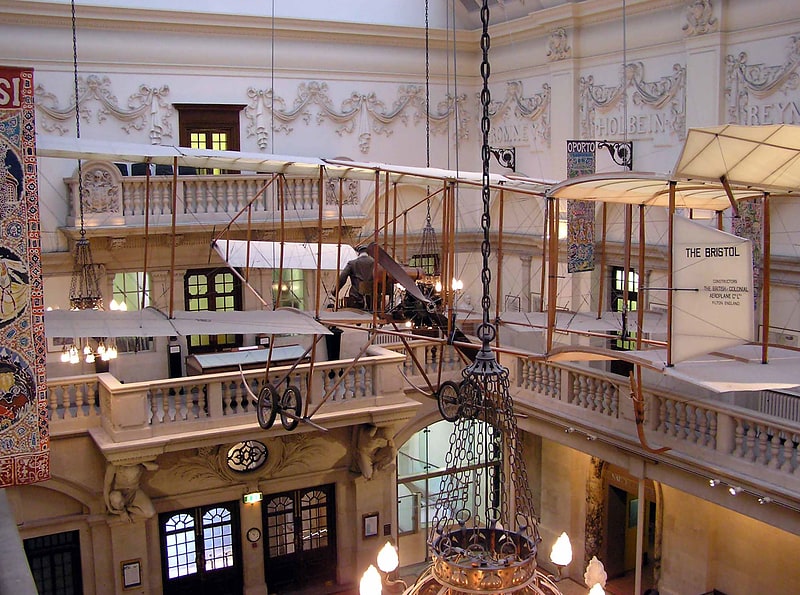
Museum in Bristol, England. Bristol Museum & Art Gallery is a large museum and art gallery in Bristol, England. The museum is situated in Clifton, about 0.5 miles from the city centre. As part of Bristol Culture it is run by the Bristol City Council with no entrance fee. It holds designated museum status, granted by the national government to protect outstanding museums. The designated collections include: geology, Eastern art, and Bristol's history, including English delftware. In January 2012 it became one of sixteen Arts Council England Major Partner Museums.
The museum includes sections on natural history as well as local, national and international archaeology. The art gallery contains works from all periods, including many by internationally famous artists, as well a collection of modern paintings of Bristol.
In the summer of 2009 the museum hosted an exhibition by Banksy featuring more than 70 works of art, including animatronics and installations; it is his largest exhibition yet. It was developed in secrecy and with no advance publicity, but soon gained worldwide attention.
The building is of Edwardian Baroque architecture and has been designated by English Heritage as a grade II* listed building.
The standard opening hours are: Tuesday to Sunday, 10am–5pm. The museum is also open 10am–5pm on Bank Holiday Mondays and Mondays during Bristol school holidays.[2]
Address: Queens Road, BS8 1RL Bristol
Arnolfini
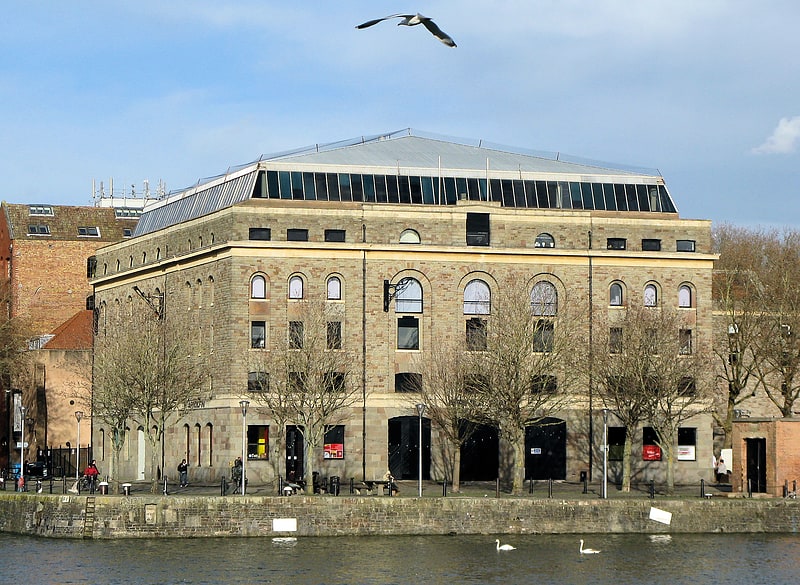
Art gallery in Bristol, England. Arnolfini is an international arts centre and gallery in Bristol, England. It has a programme of contemporary art exhibitions, artist's performance, music and dance events, poetry and book readings, talks, lectures and cinema. There is also a specialist art bookshop and a café bar. Educational activities are undertaken and experimental digital media work supported by online resources. Festivals are hosted by the gallery.
The gallery was founded in 1961 by Jeremy Rees, and was located in Clifton. In the 1970s it moved to Queen Square, before moving to its present location, Bush House on Bristol's waterfront, in 1975. The name of the gallery is taken from Jan van Eyck's 15th-century painting The Arnolfini Portrait. Arnolfini was refurbished and redeveloped in 1989 and 2005. Artists whose work has been exhibited include Bridget Riley, Rachel Whiteread, Richard Long and Jack Yeats. Performers have included Goat Island Performance Group, the Philip Glass Ensemble, and Shobana Jeyasingh Dance Company. The gallery reached a new audience in April 2010, when it was chosen to host one of the three 2010 general election debates.[3]
Address: 16 Narrow Quay, BS1 4QA Bristol
Bristol Zoo

World wildlife and plant collections. Bristol Zoo is a zoo in the city of Bristol in South West England. The zoo's stated mission is to "maintain and defend” biodiversity through breeding endangered species, conserving threatened species and habitats and promoting a wider understanding of the natural world".
The mammal collection at the zoo numbers around 300, representing 50 species, including: gorillas, Asiatic lions, goodfellow's tree-kangaroo, and red pandas. Among species now on view at Bristol which are rare or absent in other UK zoos are Livingstone's fruit bats, aye ayes and quolls.
The zoo's Twilight Zone was the first of its kind when it opened, there are many other indoor exhibits including an insect and reptile house and aquarium meanwhile outside there are several aviaries and a seal and penguin enclosure. The lakes' islands are home to gorillas, golden lion tamarins, golden-headed lion tamarins, gibbons and squirrel monkeys.
The Zoo announced on 27 November 2020 that after more than 185 years its main centre in Clifton would close in late 2022, with its animals moving to its Wild Place Project site close to the M5 motorway and the zoo reopening there in early 2024.[4]
Address: Clifton Down, BS8 3HA Bristol (Clifton)
Clifton Suspension Bridge

Iconic Victorian bridge and symbol of city. The Clifton Suspension Bridge is a suspension bridge spanning the Avon Gorge and the River Avon, linking Clifton in Bristol to Leigh Woods in North Somerset. Since opening in 1864, it has been a toll bridge, the income from which provides funds for its maintenance. The bridge is built to a design by William Henry Barlow and John Hawkshaw, based on an earlier design by Isambard Kingdom Brunel. It is a Grade I listed building and forms part of the B3129 road.
The idea of building a bridge across the Avon Gorge originated in 1753. Original plans were for a stone bridge and later iterations were for a wrought iron structure. In 1831, an attempt to build Brunel's design was halted by the Bristol riots, and the revised version of his designs was built after his death and completed in 1864. Although similar in size, the bridge towers are not identical in design, the Clifton tower having side cut-outs, the Leigh tower more pointed arches atop a 110-foot (34 m) red sandstone-clad abutment. Roller-mounted "saddles" at the top of each tower allow movement of the three independent wrought iron chains on each side when loads pass over the bridge. The bridge deck is suspended by 162 vertical wrought-iron rods in 81 matching pairs.
The Clifton Bridge Company initially managed the bridge under licence from a charitable trust. The trust subsequently purchased the company shares, completing this in 1949 and took over the running of the bridge using the income from tolls to pay for maintenance. The bridge is a distinctive landmark, used as a symbol of Bristol on postcards, promotional materials, and informational web sites. It has been used as a backdrop to several films and television advertising and programmes. It has also been the venue for significant cultural events such as the first modern bungee jump in 1979, the last Concorde flight in 2003 and a handover of the Olympic Torch relay in 2012.[5]
Address: Suspension Bridge Road, BS8 4AP Bristol (Clifton)
Tyntesfield
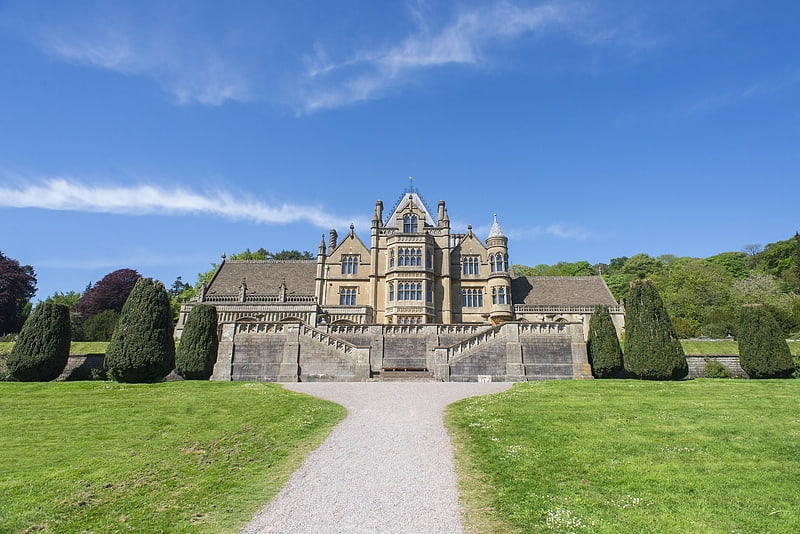
Building in England. Tyntesfield is a Victorian Gothic Revival house and estate near Wraxall, North Somerset, England. The house is a Grade I listed building named after the Tynte baronets, who had owned estates in the area since about 1500. The location was formerly that of a 16th-century hunting lodge, which was used as a farmhouse until the early 19th century. In the 1830s a Georgian mansion was built on the site, which was bought by English businessman William Gibbs, whose huge fortune came from guano used as fertilizer. In the 1860s Gibbs had the house significantly expanded and remodelled; a chapel was added in the 1870s. The Gibbs family owned the house until the death of Richard Gibbs in 2001.
Tyntesfield was purchased by the National Trust in June 2002, after a fundraising campaign to prevent it being sold to private interests and ensure it would be open to the public. The house was opened to visitors for the first time just 10 weeks after the acquisition, and as more rooms are restored they are added to the tour.
The mansion was visited by 356,766 people in 2019.[6]
Address: Wraxall, BS48 1NX, Bristol
Bristol Cathedral
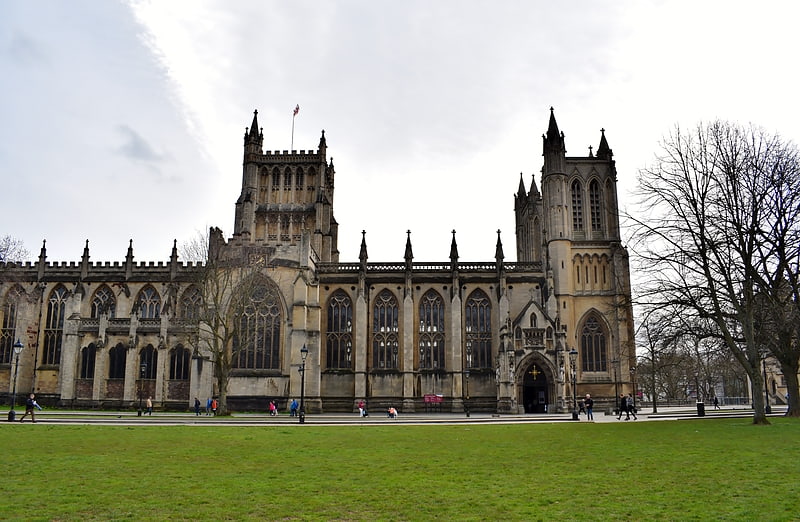
Cathedral in Bristol, England. Bristol Cathedral, formally the Cathedral Church of the Holy and Undivided Trinity, is the Church of England cathedral in the city of Bristol, England. Founded in 1140 and consecrated in 1148, it was originally St Augustine's Abbey but after the Dissolution of the Monasteries it became in 1542 the seat of the newly created Bishop of Bristol and the cathedral of the new Diocese of Bristol. It is a Grade I listed building.
The eastern end of the church includes fabric from the 12th century, with the Elder Lady Chapel which was added in the early 13th century. Much of the church was rebuilt in the English Decorated Gothic style during the 14th century despite financial problems within the abbey. In the 15th century the transept and central tower were added. The nave was incomplete at the Dissolution of the Monasteries in 1539 and was demolished. In the 19th century Gothic Revival a new nave was built by George Edmund Street partially using the original plans. The western twin towers, designed by John Loughborough Pearson, were completed in 1888.
Located on College Green, the cathedral has tall Gothic windows and pinnacled skyline. The eastern end is a hall church in which the aisles are the same height as the Choir and share the Lierne vaults. The late Norman chapter house, situated south of the transept, contains some of the first uses of pointed arches in England. In addition to the cathedral's architectural features, it contains several memorials and an historic organ. Little of the original stained glass remains with some being replaced in the Victorian era and further losses during the Bristol Blitz.[7]
Address: College Green, BS1 5TJ Bristol
SS Great Britain
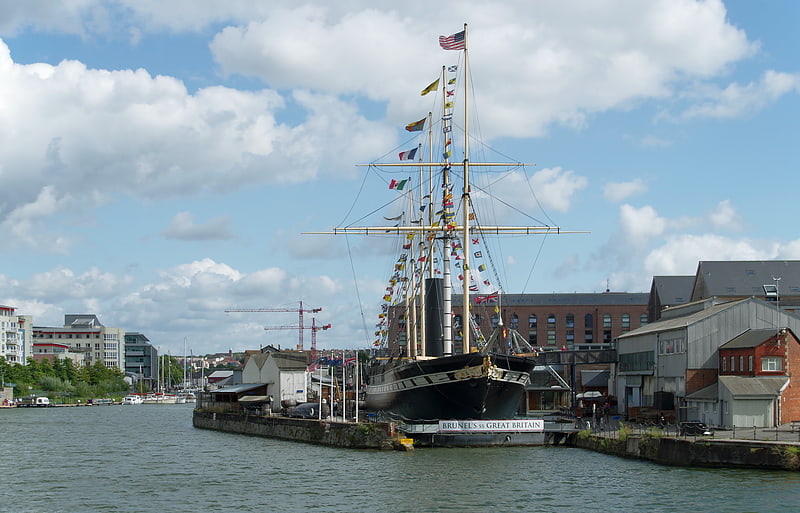
Living museum on Brunel's iron steamship. SS Great Britain is a museum ship and former passenger steamship that was advanced for her time. She was the largest passenger ship in the world from 1845 to 1854. She was designed by Isambard Kingdom Brunel, for the Great Western Steamship Company's transatlantic service between Bristol and New York City. While other ships had been built of iron or equipped with a screw propeller, Great Britain was the first to combine these features in a large ocean-going ship. She was the first iron steamer to cross the Atlantic Ocean, which she did in 1845, in 14 days.
The ship is 322 ft (98 m) in length and has a 3,400-ton displacement. She was powered by two inclined two-cylinder engines of the direct-acting type, with twin high pressure cylinders (diameter uncertain) and twin low pressure cylinders 88 in (220 cm) bore, all of 6-foot (1.8 m) stroke cylinders. She was also provided with secondary masts for sail power. The four decks provided accommodation for a crew of 120, plus 360 passengers who were provided with cabins, and dining and promenade saloons.
When launched in 1843, Great Britain was by far the largest vessel afloat. But her protracted construction time of six years (1839–1845) and high cost had left her owners in a difficult financial position, and they were forced out of business in 1846, having spent all their remaining funds refloating the ship after she ran aground at Dundrum Bay in County Down near Newcastle in what is now Northern Ireland, after a navigation error. In 1852 she was sold for salvage and repaired. Great Britain later carried thousands of emigrants to Australia from 1852 until being converted to all-sail in 1881. Three years later, she was retired to the Falkland Islands, where she was used as a warehouse, quarantine ship and coal hulk until she was scuttled in 1937, 98 years after being laid down.
In 1970, after Great Britain had been abandoned for 33 years, Sir Jack Arnold Hayward, OBE (1923–2015) paid for the vessel to be raised and repaired enough to be towed north through the Atlantic back to the United Kingdom, and returned to the Bristol dry dock where she had been built 127 years earlier. Hayward was a prominent businessman, developer, philanthropist and owner of the English football club Wolverhampton Wanderers. Now listed as part of the National Historic Fleet, Great Britain is a visitor attraction and museum ship in Bristol Harbour, with between 150,000 and 200,000 visitors annually.[8]
Address: Great Western Dockyard, BS1 6TY Bristol
Blaise Castle Estate
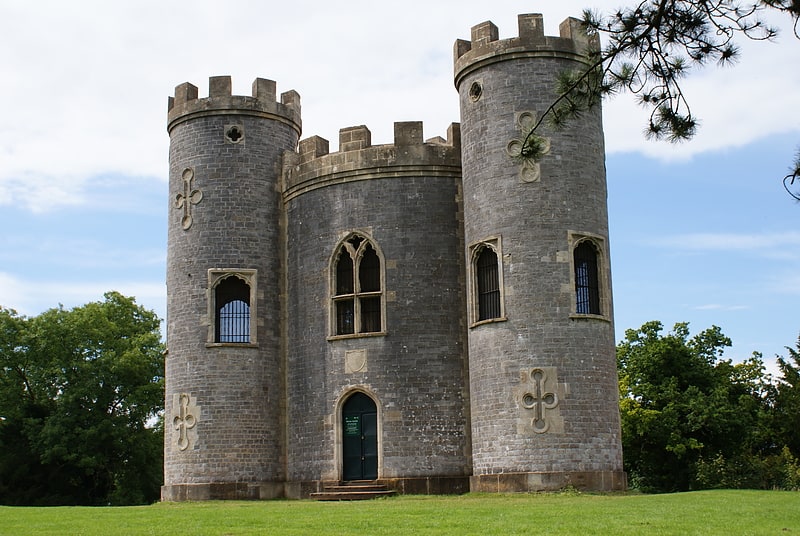
Castle in Bristol, England. Blaise Castle is a folly built in 1766 near Henbury in Bristol, England. The castle sits within the Blaise Castle Estate, which also includes Blaise Castle House, a Grade II* listed 18th-century mansion house. The folly castle is also Grade II* listed and ancillary buildings including the orangery and dairy also have listings. Along with Blaise Hamlet, a group of nine small cottages around a green built in 1811 for retired employees, and various subsidiary buildings, the parkland is listed Grade II* on the Register of Historic Parks and Gardens of special historic interest in England.
The site has signs of occupation during the Neolithic, Bronze Age, Iron Age and Roman periods. After the Dissolution of the Monasteries the site was sold. In 1766 Thomas Farr commissioned Robert Mylne to build the sham castle in Gothic Revival style. After Farr's bankruptcy, the estate was sold several times until purchased by John Scandrett Harford, who demolished the previous dwelling in 1789 and built the Neoclassical Blaise Castle House. His son, also named John Scandrett Harford, continued with the development of the buildings and estate, which his family occupied until 1926, when it was bought by Bristol City Council. The park was laid out by Humphry Repton in the early 19th century. The estate is now owned by Bristol City Council. The house is run as a museum by the Bristol City Museum and Art Gallery and holds a variety of collections. The Picture Room, added in the 1830s, is hung with paintings, mostly of the 19th century. There are selections on display from Bristol Museum's 10,000 items of historic costume, and of toys from the 18th century to the 1980s.[9]
Redcliffe Caves
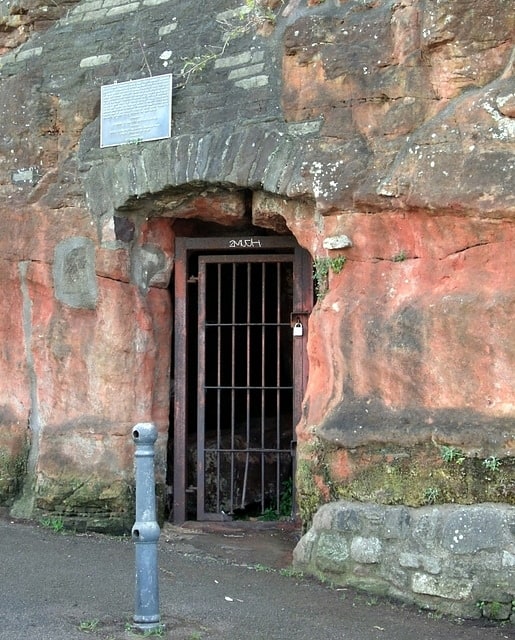
Historical landmark in Bristol, England. Redcliffe Caves are a series of man made tunnels beneath the Redcliffe area of Bristol, England.
The Triassic red sandstone was dug into in the Middle ages to provide sand for glass making and pottery production. Further excavation took place from the 17th to early 19th centuries and used for storage of trade goods. There is some evidence that prisoners captured during the French Revolutionary Wars or Napoleonic Wars were imprisoned in the caves but it is clear that the local folklore that slaves were imprisoned in the caves during the Bristol slave trade is false. After the closure of the last glass factory the caves were used for storage and became a rubbish dump. The caves are not generally open but have been used for film and music events.
The explored and mapped area covers over 1 acre (0.40 ha) however several areas are no longer accessible and the total extent of the caves is not known.[10]
Address: Phoenix Wharf, Bristol
Cabot Tower
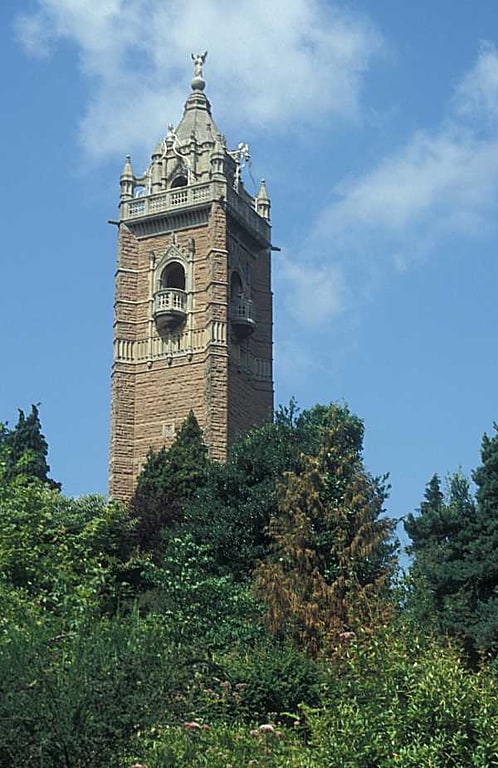
Tower in Bristol, England. Cabot Tower is a tower in Bristol, England, situated in a public park on Brandon Hill, between the city centre, Clifton and Hotwells. It is a grade II listed building.
The tower was built in the 1890s to commemorate the 400th anniversary of the journey of John Cabot from Bristol to land which later became Canada. Public access to the viewing platforms at the top of the tower was suspended from 2007 to 2011 for repairs.[11]
Address: Brandon Hill Park, Great George St, BS1 5RR Bristol
College Green
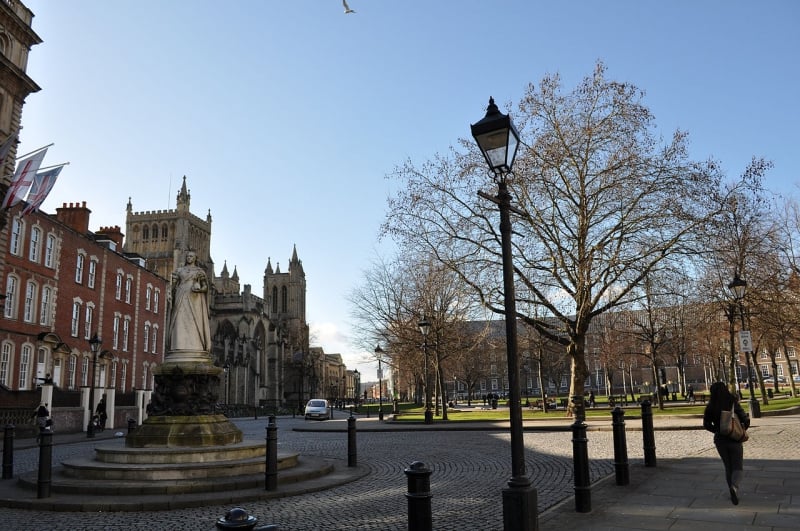
Student dormitory in Bristol, England. College Green is a public open space in Bristol, England. The Green takes the form of a segment of a circle with its apex pointing east, and covers 1.1 hectares. The road named College Green forms the north-eastern boundary of the Green, Bristol Cathedral marks the south side, and City Hall closes the Green in an arc to the north-west.
College Green is owned by the Dean and Chapter of Bristol Cathedral, and managed by Bristol City Council.[12]
Address: College Green, BS1 5SP Bristol
St Mary Redcliffe

Parish church. St Mary Redcliffe is an Anglican parish church located in the Redcliffe district of Bristol, England. The church is a short walk from Bristol Temple Meads station. The church building was constructed from the 12th to the 15th centuries, and it has been a place of Christian worship for over 900 years. The church is renowned for the beauty of its Gothic architecture and is classed as a Grade I listed building by Historic England. It was famously described by Queen Elizabeth I as "the fairest, goodliest, and most famous parish church in England."
Little remains of the earliest churches on the site although a little of the fabric has been dated to the 12th century. Much of the current building dates from the late 13th and 14th centuries when it was built and decorated by wealthy merchants of the city whose tomb and monuments decorate the church. The spire fell after being struck by lightning in 1446 and was not rebuilt until 1872. Little of the original stained glass remains following damage in the English Civil War with extensive new glass being added during the Victorian era. The tower contains 14 bells designed for full-circle English-Style change ringing. Other music in the church is provided by several choirs and the Harrison & Harrison organ.[13]
Address: Parish Office 12 Colston Parade, BS1 6RA Bristol
Castle Park
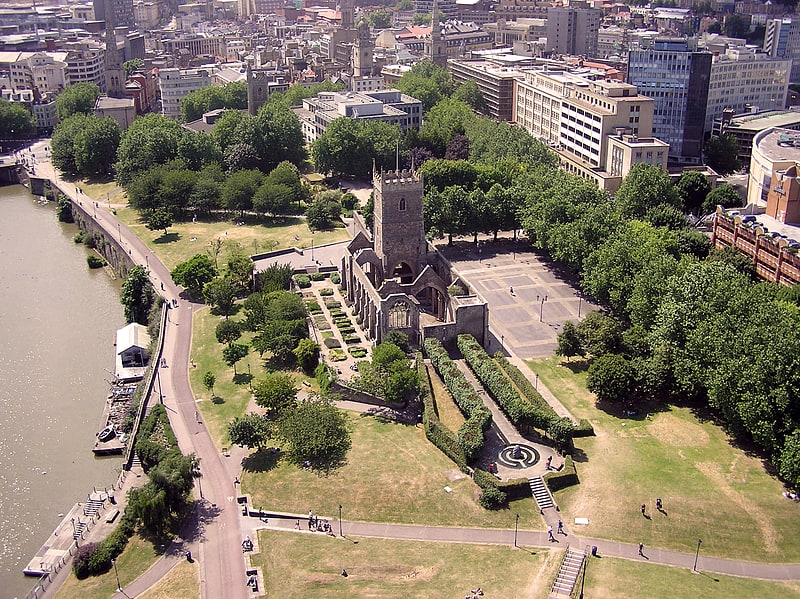
City park in Bristol, England. Castle Park is a public open space in Bristol, England, managed by Bristol City Council. It is bounded by the Floating Harbour and Castle Street to the south, Lower Castle Street to the east, and Broad Weir, Newgate and Wine Street to the north. Its western boundary is less obviously defined and has been the subject of controversy, perhaps because the area around High Street and St Mary le Port Church, though not part of the park and always intended for development, is often considered at the same time as the park.
Opened on 30 September 1978, the park occupies the site of what was once Bristol's main shopping district. The area was largely destroyed by the Luftwaffe during the Blitz, and that which remained was subsequently demolished by 1969, the last demolitions being the Bear & Rugged Staff and the Cat and Wheel pubs in Little Peter Street. In the years since the end of the Second World War, Castle Park has become home to a number of anti-fascist memorials.
The ruined 14th century tower of St Mary-le-Port Church stands to the west of the park, surrounded by derelict financial office buildings. Adjoining the ruins of St Peter's Church in the middle of the park is a sensory herb garden on the site of the former St Peters Churchyard cleared 1965, and five silver birch trees as a memorial to the beaches of the D-Day landings. To the east is a grassy arena covering Castle Green and the west half of Castle Street, and the partially excavated remains of the great stone keep Bristol Castle with 2 preserved vaulted chambers formerly in Castle Green (Tower Street) farther east. There is also a bandstand.
Tree-lined St Peter's Square, to the north of St Peter's church, (formerly Dolphin Street, Peter Street and Church or Chequer Lane) has been home to various events including German Christmas markets. In recent summers a tethered balloon was placed near the bandstand, offering ascents to sightseers.
Recent attempts to develop the area between the park's western edge and High Street have proved controversial; Bristol City Council are keen to replace the derelict 1963/4 buildings with a mixed-use development to help reconnect the Old City to Broadmead and raise funds to improve the park; others would rather see the park extended to High Street.[14]
Address: Castle Street, Bristol
Kings Weston House
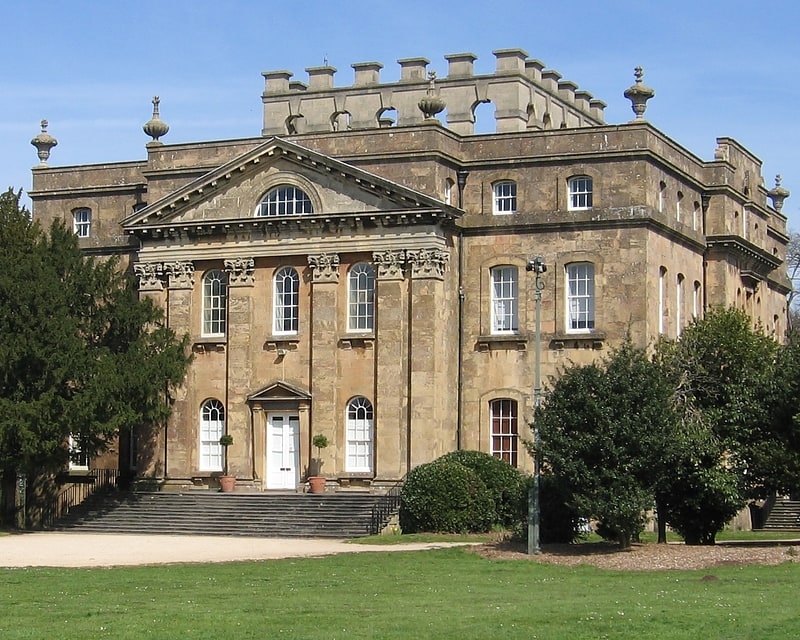
Building in Bristol, England. Kings Weston House is a historic building in Kings Weston Lane, Kingsweston, Bristol, England.[15]
Address: Kings Weston Lane, Bristol
Royal West of England Academy
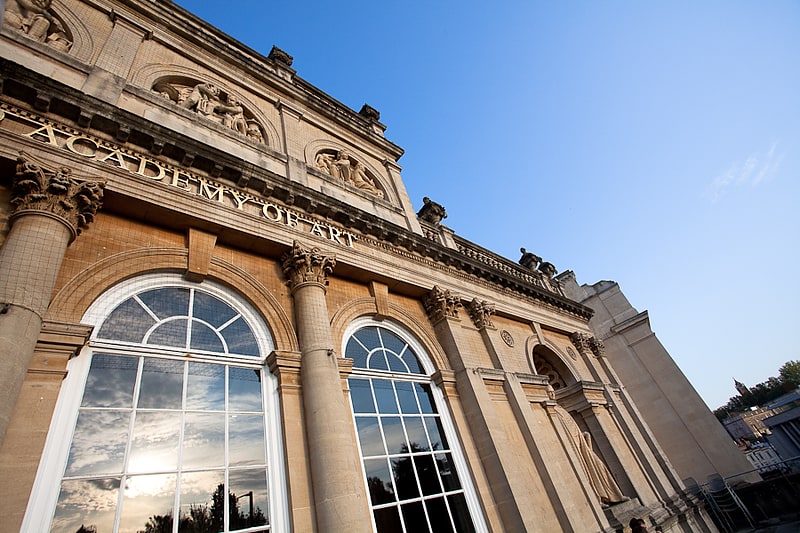
Art gallery in Bristol, England. The Royal West of England Academy is Bristol's oldest art gallery, located in Clifton, Bristol, near the junction of Queens Road and Whiteladies Road. Situated in a Grade 2* listed building, it hosts five galleries and an exhibition programme that celebrates the best of historic and contemporary British art.
Elected Royal West of England Academicians use the post-nominal RWA.[16]
Address: Queens Road, BS8 1PX Bristol
Watershed

Cinema in Bristol, England. Watershed opened in June 1982 as the United Kingdom's first dedicated media centre. Based in former warehouses on the harbourside at Bristol, it hosts three cinemas, a café/bar, events/conferencing spaces, the Pervasive Media Studio, and office spaces for administrative and creative staff. It occupies the former E and W sheds on Canon's Road at Saint Augustine's Reach, and underwent a major refurbishment in 2005. The building also hosts UWE eMedia Business Enterprises, Most of Watershed's facilities are situated on the second floor of two of the transit sheds. The conference spaces and cinemas are used by many public and private sector organisations and charities. Watershed employs the equivalent of over seventy full-time staff and has an annual turnover of approximately £3.8 million. As well as its own commercial income, Watershed Arts Trust is funded by national and regional arts funders.
A 2010 report for the International Futures Forum describes the Watershed as "a creative ecosystem, operating in many different and overlapping economies," which is "pushing the creative boundary" by fostering both the invention and consolidation of new work.[17]
Address: 1 Canon's Rd, BS1 5TX Bristol
St Mary le Port Church
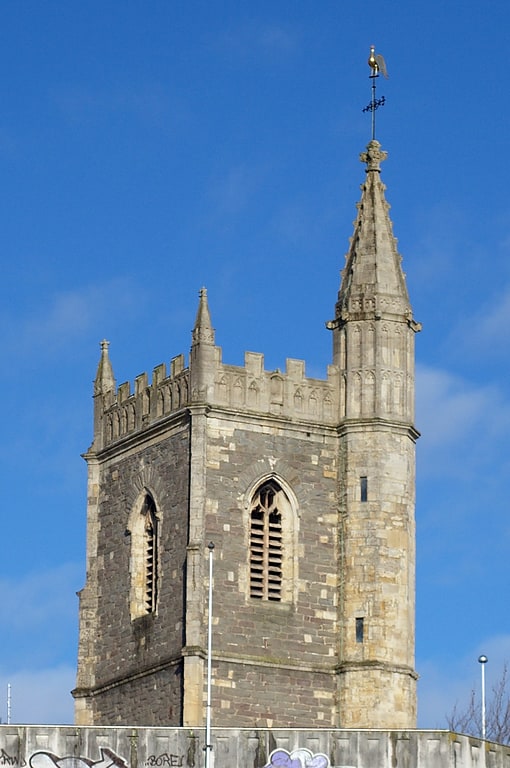
Parish church in Bristol, England. St Mary le Port is a ruined parish church in the centre of Bristol, England, situated in Castle Park on what remains of Mary le Port Street.[18]
Cube Microplex
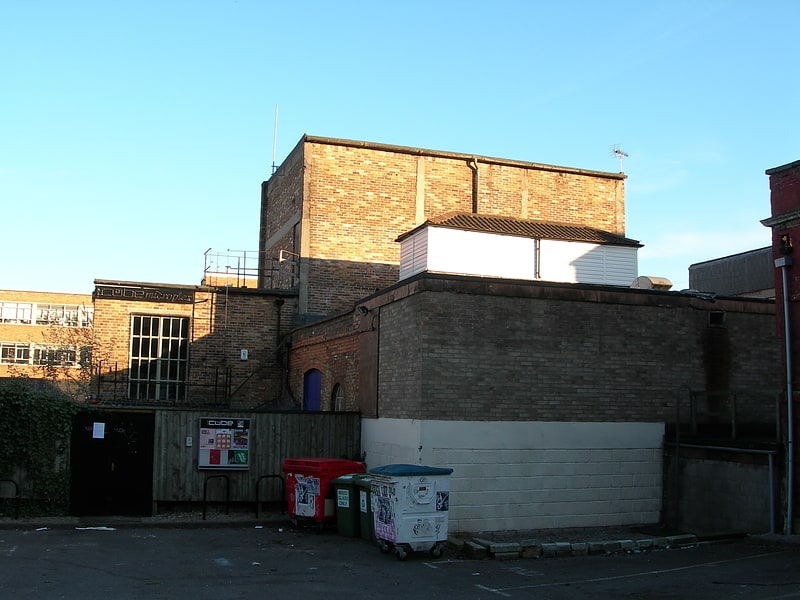
Cinema in Bristol, England. The Cube Microplex is cinema and event venue in Bristol, England. It operates as a non-profit cooperative and is entirely staffed by volunteers. Since opening in 1998 it has hosted international and local artistic and cultural events including films and music performances as well as providing a focal point for Bristol's artistic community. The building includes a roughly 108 seat auditorium as well as a bar serving local and ethical products.[19]
Address: 4 Princess Row, BS2 8NQ Bristol
Clifton Cathedral

Daily choral music in Catholic cathedral. The Cathedral Church of SS. Peter and Paul is the Roman Catholic cathedral of the city of Bristol. Located in the Clifton area of the city, it is the seat and mother church of the Diocese of Clifton and is known as Clifton Cathedral. It has been a Grade II* Listed Building since 2000. A 2014 study noted it to be the only Catholic church built in the 1970s to have been Grade II* listed. It was the first Cathedral built under new guidelines arising from the Second Vatican Council.[20]
Address: Clifton Park, BS8 3BX Bristol (Clifton)
Colston Hall
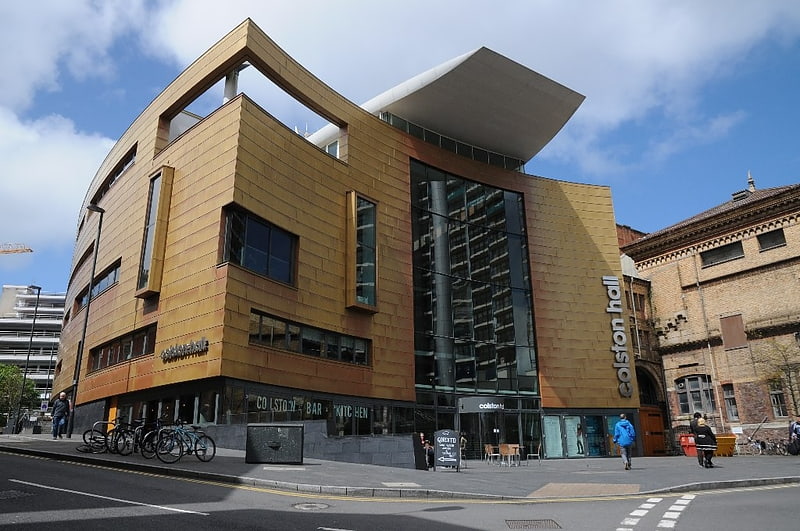
Concert hall in Bristol, England. Bristol Beacon, previously known as Colston Hall, is a concert hall and Grade II listed building on Colston Street, Bristol, England. It is owned by Bristol City Council. Since 2011, management of the hall has been the direct responsibility of Bristol Music Trust.
The hall first opened as a concert venue in 1867, and became a popular place for classical music and theatre. In the mid-20th century, wrestling matches were in strong demand, while in the late 1960s it developed into one of the most important rock music venues in Britain. The hall has been redeveloped several times, and was gutted by two fires in 1898 and 1945, though the original Bristol Byzantine foyer has survived. A major refurbishment, adding an extra wing, opened in 2009 and redevelopment of the cellars was planned by 2019.
The hall's official capacity is 2,075, with an additional 350 in "The Lantern", built as part of the 2009 redevelopments. As well as the main entertainment areas, there are a number of licensed bars and a restaurant.
The hall was formerly named after the slave trader, merchant and philanthropist Edward Colston, who founded Colston's School on this site in the early 18th century. The decision to rename was taken in 2017 to coincide with a major redevelopment of the venue, after a number of years' debates and campaigns regarding Colston's ties to the Atlantic slave trade. The renaming was brought forward in September 2020 following anti-racism protests in Bristol that summer.[21]
Address: Colston St, Bristol
Temple Church

Building in Bristol, England. Temple Church, also known as Holy Cross Church, is a ruined church in Redcliffe, Bristol, England. It is on the site of a previous, round church of the Knights Templar, which they built on land granted to them in the second quarter of the 12th century by Robert of Gloucester. In 1313 the Knights Hospitaller acquired the church, following the suppression of the Templars, only to lose it in 1540 at the time of the Dissolution of the Monasteries. By the early 14th century, the church served as the parish church for the area known as Temple Fee. From around the same time, the rebuilding of the church on a rectangular plan started. This was completed by 1460, with the construction of a leaning west tower.
The church was the scene of the exorcism of George Lukins conducted by Methodist and Anglican clergy in 1788.
The church was bombed and largely destroyed in the Bristol Blitz. It is a Grade II* listed building, owned by the Diocese of Bristol. In 1958, English Heritage agreed to undertake a guardianship role. A 1960 excavation by the Ministry of Works discovered the plan of the 12th-century church, enabling it to be marked out on the ground in stone.[22]
Address: Victoria St, BS1 6HS Bristol
Memorial Stadium
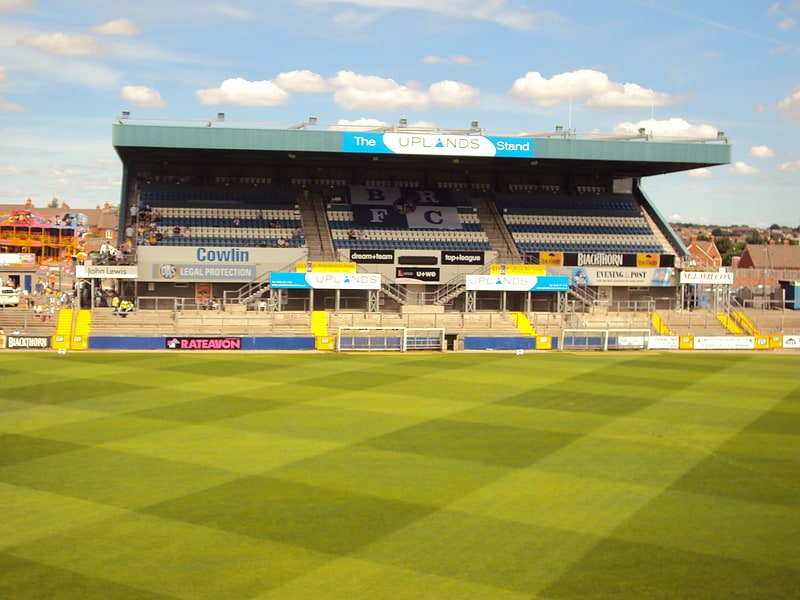
Stadium in Bristol, England. The Memorial Stadium, also commonly known by its previous name of the Memorial Ground, is a sports ground in Bristol, England, and is the home of Bristol Rovers F.C. It opened in 1921 dedicated to the memory of local rugby union players killed during the First World War, and was the home of Bristol Bears rugby club until they moved to Ashton Gate in 2014.[23]
Address: Filton Avenue, Horfield, BS7 0BF Bristol
We the Curious
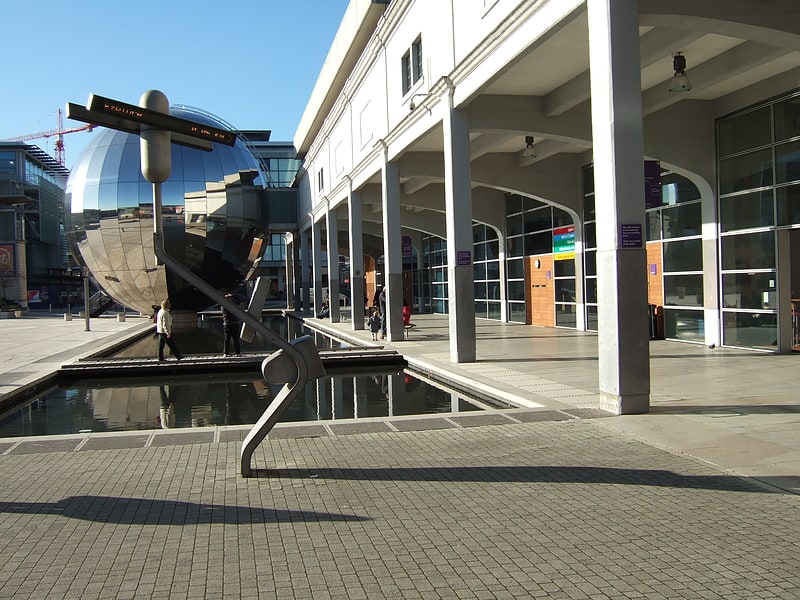
Science museum in Bristol, England. We The Curious is a science and arts centre and educational charity in Bristol, England. It features over 250 interactive exhibits over two floors, and members of the public and school groups can also engage with the Live Science Team over programming in the kitchen, studio and on live lab. We The Curious is also home of the United Kingdom's first 3D planetarium. The centre describes its aim as being "to create a culture of curiosity".
As part of its charitable status, We The Curious has an extensive community engagement programme. In regular weekends throughout the year We The Curious hosts "Hello!" weekends for communities who are currently under-represented in their visitors while also providing a community membership for charities and groups working in and for the community. Alongside this, We The Curious is working with local schools and community groups to plan exhibits and programming for the future.[24]
Address: 2 Anchor Rd, BS1 5DB Bristol
Clifton Observatory
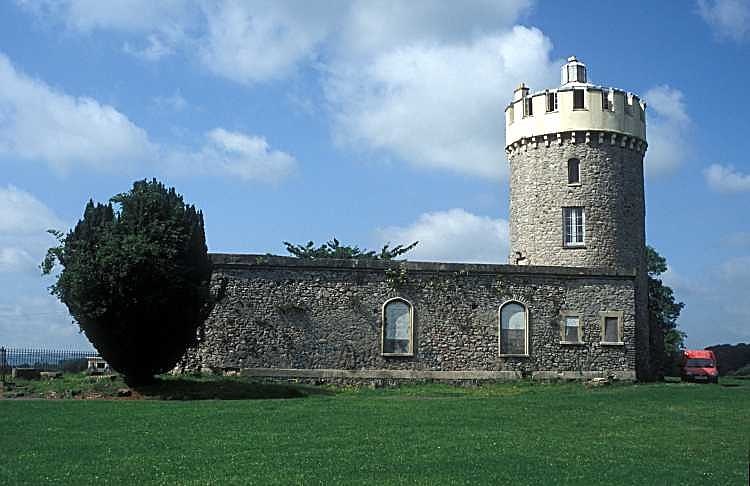
Building in Bristol, England. Clifton Observatory is a former mill, now used as an observatory, located on Clifton Down, close to the Clifton Suspension Bridge, Bristol, England.
The building was erected, with the permission of the Society of Merchant Venturers, as a windmill for corn in 1766 and later converted to the grinding of snuff, when it became known as 'The Snuff Mill'. This was damaged by fire on 30 October 1777, when the sails were left turning during a gale and caused the equipment to catch alight. It was then derelict for 52 years until in 1828 William West, an artist, rented the old mill, for 5 shillings (25p) a year, as a studio.
In 1977, the Merchant Venturers sold the observatory to Honorbrook Inns; however, they were obliged to maintain public access to the camera obscura whose ownership was retained by the Merchant Venturers.
It has been designated by English Heritage as a grade II* listed building and is on the Buildings at Risk Register. In February 2015 the Observatory was bought by Ian Johnson, a local Clifton-born entrepreneur, who also owns the Clifton Rocks Railway and the Wellhead cocktail bar.[25]
Address: Clifton Down, BS8 3LT Bristol (Clifton)
Clifton Down
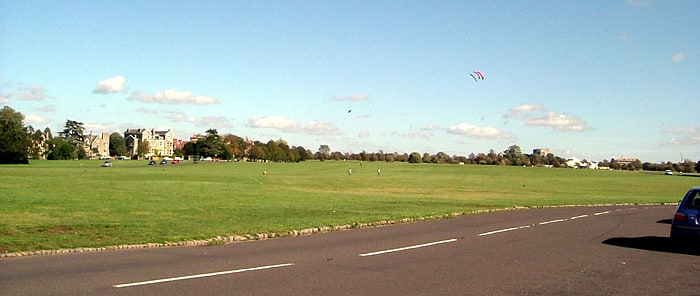
Park in Bristol, England. Clifton Down is an area of public open space in Bristol, England, north of the village of Clifton. With its neighbour Durdham Down to the northeast, it constitutes the large area known as The Downs, much used for leisure including walking and team sports. Clifton Down is the part of the Downs south of Stoke Road.[26]
Avon Gorge
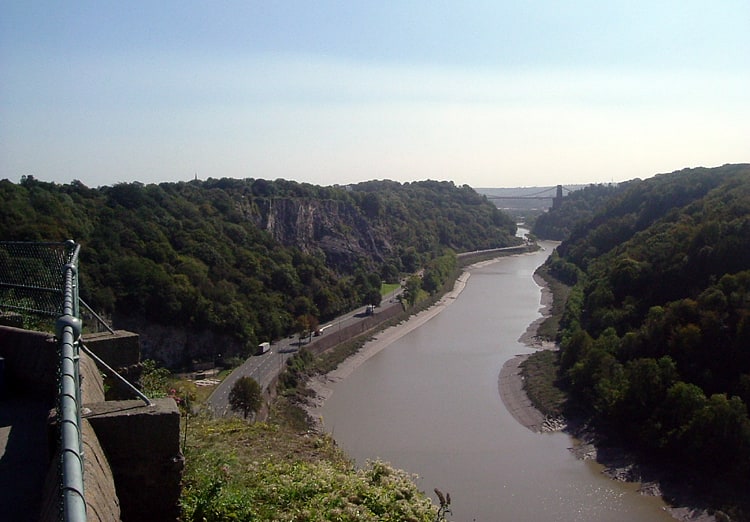
Gorge in the United Kingdom. The Avon Gorge is a 1.5-mile long gorge on the River Avon in Bristol, England. The gorge runs south to north through a limestone ridge 1.5 miles west of Bristol city centre, and about 3 miles from the mouth of the river at Avonmouth. The gorge forms the boundary between the unitary authorities of North Somerset and Bristol, with the boundary running along the south bank. As Bristol was an important port, the gorge formed a defensive gateway to the city.
On the east of the gorge is the Bristol suburb of Clifton, and The Downs, a large public park. To the west of the gorge is Leigh Woods, the name of both a village and the National Trust forest it is situated in. There are three Iron Age hill forts overlooking the gorge, as well as an observatory. The Clifton Suspension Bridge, an icon of Bristol, crosses the gorge.[27]
Ashton Gate Stadium

Stadium in Bristol, England. Ashton Gate is a stadium in Ashton Gate, Bristol, England, and is the home of Bristol City and the Bristol Bears. Located in the south-west of the city, just south of the River Avon, it currently has an all-seated capacity of 27,000.[28]
Address: Ashton Road, BS3 2EJ Bristol
St Peter's Church
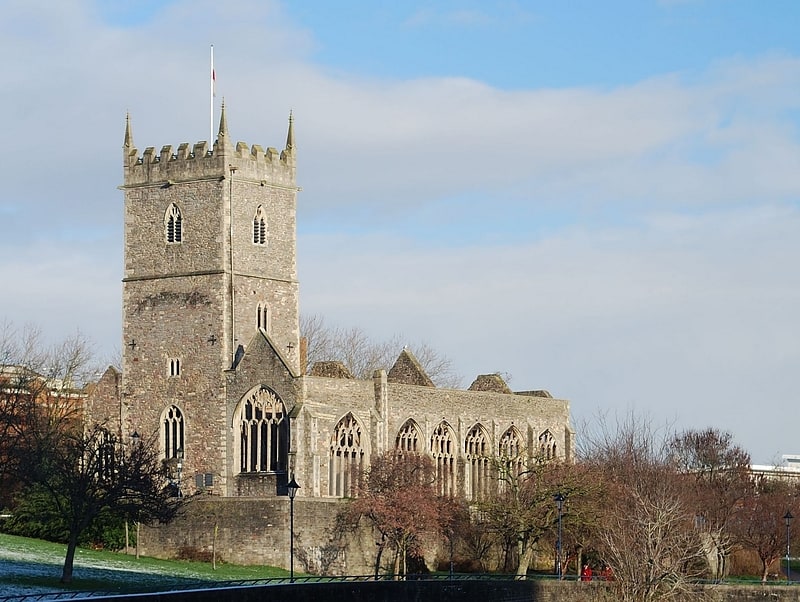
Building in Bristol, England. St Peter's Church is a ruined church in Castle Park, Bristol, England. It was bombed during World War II and is now preserved as a memorial.
The foundation of the church can be traced back to 1106 when it was endowed on Tewkesbury Abbey, with a 12th-century lower tower, the rest of the church being built in the 15th century. Excavations in 1975 suggest that this was the site of Bristol's first church; the 12th-century city wall runs under the west end of the present church. It was bombed during the Bristol Blitz of 24–25 November 1940 and ruined. It is maintained as a monument to the civilian war dead of Bristol.
It has been designated by English Heritage as a grade II* listed building.
The church ran St Peter's Hospital, a workhouse located between the church and Floating Harbour which was destroyed by bombing during the Bristol Blitz.[29]
Address: Castle Park, BS1 3XB Bristol
All Saints Clifton
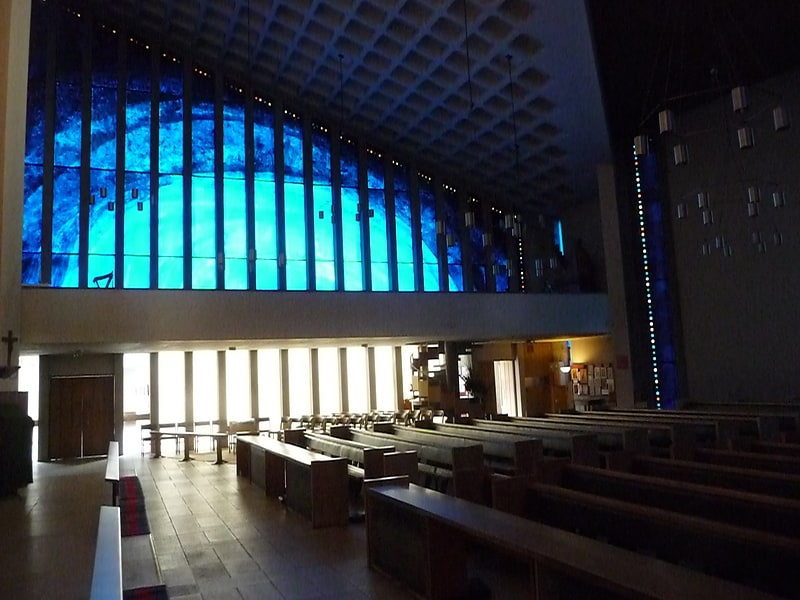
Episcopal church in Bristol, England. The Church of All Saints is a Church of England parish church in Clifton, Bristol. The church is a grade II listed building. It is located in the Parish of All Saints with St. John Clifton in the Diocese of Bristol.[30]
Address: Pembroke Rd, BS8 3ED Bristol
Oldbury Court Estate
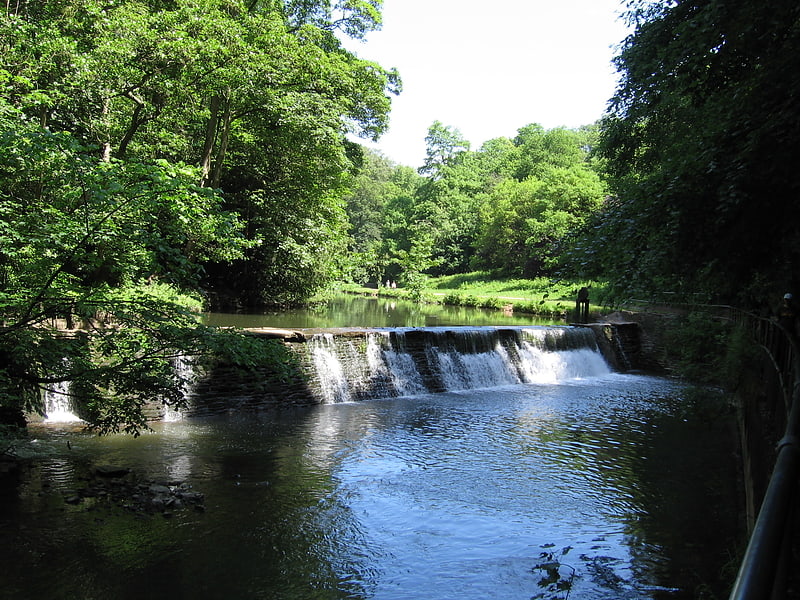
Park in Bristol, England. Oldbury Court Estate is a park in Fishponds, Bristol, about 3 miles north-east of the city centre.
It is a park of Bristol City Council, and is listed Grade II in English Heritage's Register of Historic Parks and Gardens of Special Historic Interest. Its area is 23.33 hectares (57.6 acres); the parkland contains woods and riverside wildlife. The paths along the River Frome form part of the Frome Valley Walkway. There are picnic areas and a children's play park.[31]
Address: Gill Avenue, Bristol
Hydraulic engine house
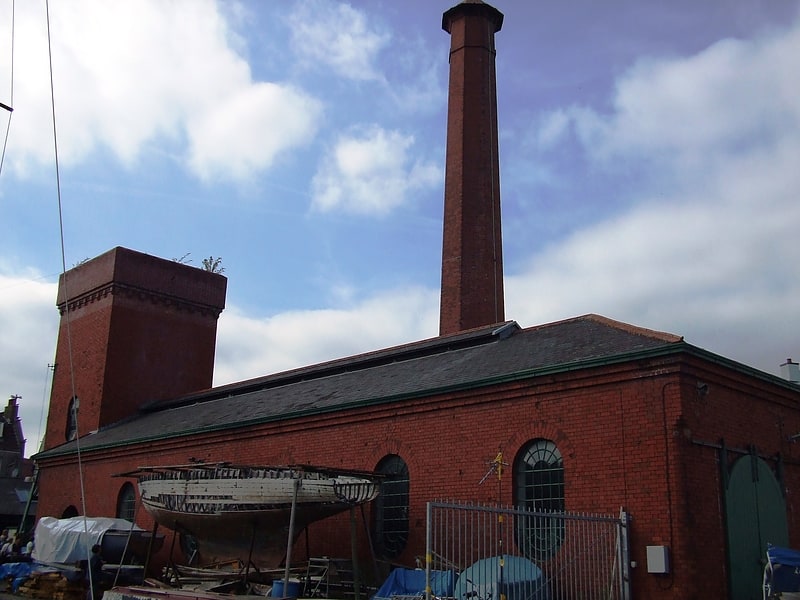
The Hydraulic engine house is part of the "Underfall Yard" in Bristol Harbour in Bristol, England.
The octagonal brick and terracotta chimney of the engine house dates from 1888, and is grade II* listed, as is the hydraulic engine house itself. It replaced the original pumping house which is now The Pump House public house. It is built of red brick with a slate roof and originally contained two steam engines made by the Worthington Corporation. These were compound surface condensing cylinders of 17.5 inches (440 mm) diameter. These were replaced in 1907 by the current machines from Fullerton, Hodgart and Barclay of Paisley. It powered the docks' hydraulic system of cranes, bridges and locks until 2010.
Water is pumped from the harbour to a header tank and then fed by gravity to the high pressure pumps, where it is pressurised thence raising the external hydraulic accumulator. This stores the hydraulic energy ensuring a smooth delivery of pressure and meaning that the pumps do not need to be running the whole time nor be capable of supplying the instantaneous peak demands. The working pressure is 750 lbs/square inch. The external accumulator was added about 1954 when the original inside the building's tower became difficult to service (but it remains in place). The building originally contained a pair of steam powered pumps however these were replaced with three electrically driven ones in 1907. The engine house provided the power for equipment such as the lock gates and cranes until 2010.
The visitor centre in the hydraulic power house opened in time for Easter 2016.[32]
Address: Avon Crescent, Bristol
Pero's Bridge
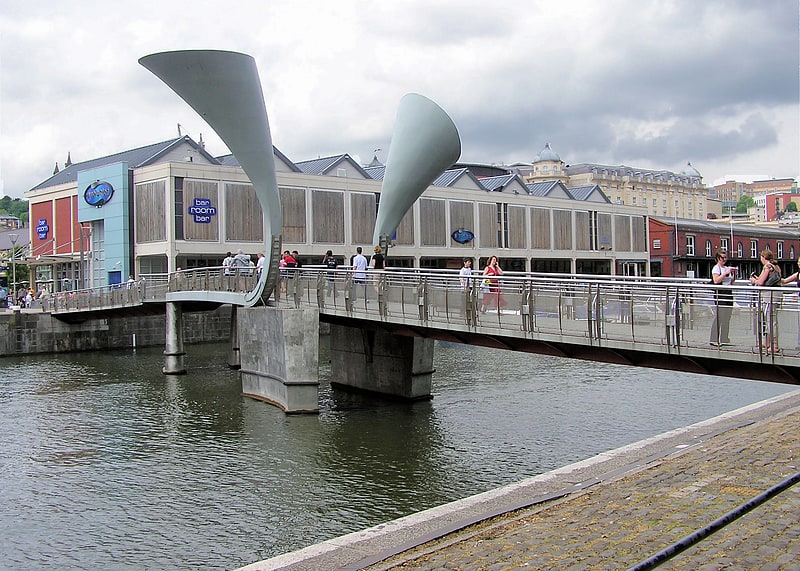
Bascule bridge in Bristol, England. Pero's Bridge is a pedestrian bascule bridge that spans St Augustine's Reach in Bristol Harbour, Bristol, England. It links Queen Square and Millennium Square.[33]
Address: Narrow Quay, BS1 Bristol
Victoria Rooms
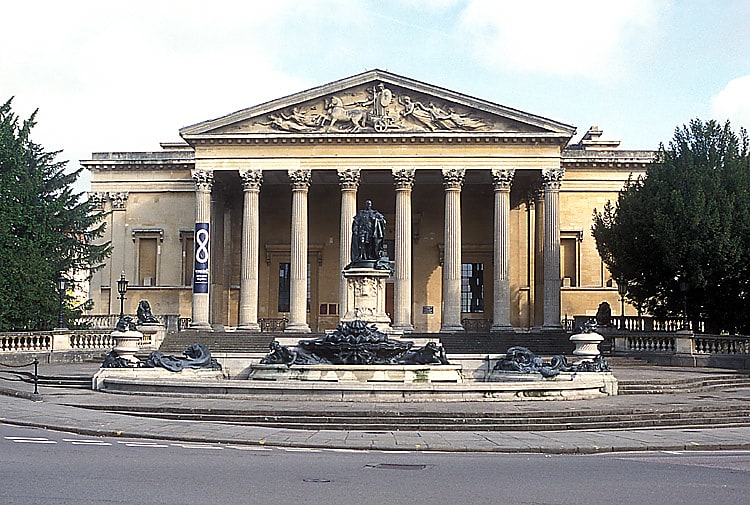
Building in Bristol, England. The Victoria Rooms, also known as the Vic Rooms, houses the University of Bristol's music department in Clifton, Bristol, England, on a prominent site at the junction of Queens Road and Whiteladies Road. The building, originally assembly rooms, was designed by Charles Dyer and was constructed between 1838 and 1842 in Greek revival style, and named in honour of Queen Victoria, who had acceded to the throne in the previous year. An eight column Corinthian portico surmounts the entrance, with a classical relief sculpture designed by Musgrave Watson above. The construction is of dressed stonework, with a slate roof. A bronze statue of Edward VII, was erected in 1912 at the front of the Victoria Rooms, together with a curved pool and several fountains with sculptures in the Art Nouveau style.
The Victoria Rooms contain a 665-seat auditorium, a lecture theatre, recital rooms, rehearsal rooms and a recording studio. Jenny Lind and Charles Dickens performed at the Victoria Rooms. It was also the venue for important dinners and assemblies, including banquets to commemorate the opening of the Clifton Suspension Bridge and the quatercentennial anniversary of Cabot's discovery of North America, meetings which led to the establishment of the University College, Bristol, an early congress of the British Association for the Advancement of Science and suffragettes "at-homes". The building was purchased and given to the University in 1920 as a home for the student union and, circa 1924, it spent a brief period as a cinema. Following a fire in 1934, the building was refurbished by the University. It remained as the base of the student union until purpose built facilities were opened in Queens Road in the 1960s. The Victoria Rooms then became an exhibition and conference centre, before housing the music department in 1996. They remain in use in the 21st century for concerts, exhibitions, plays, recitals and lectures.[34]
Address: Victoria Rooms Queens Road, BS8 1SA Bristol
St Mary on the Quay
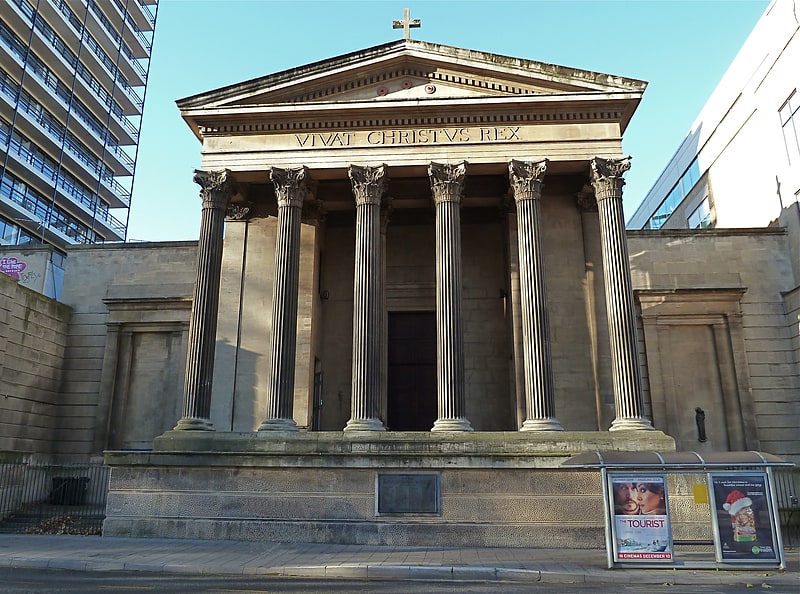
Parish church in Bristol, England. St Mary on the Quay is a Roman Catholic Parish church in Bristol, England. It is situated on Colston Avenue, next to Colston Tower in the centre of the city. It is the oldest Roman Catholic church in Bristol; the first one built after the Reformation. it was formerly administered by the Society of Jesus and is currently served by the Divine Word Missionaries. It is a Grade II* listed building.[35]
Address: 20 Colston Ave, BS1 5AE Bristol